One of the reasons that people chose to have chickens is that we like to look at them. Feathers shimmer in a range of gorgeous hues. Their fluffy-feathered bottoms are both charming and comical. Some breeds are sleek, and some, like my cochin, Pearl, look like a fussy Victorian lady.
What we don’t picture, when we get chickens for the first time, is all of the runny manure and other unpleasant things that stream out their backsides. Any hint of disease often first shows up as diarrhea. Then, there’s lice and mites which cause red, bare bottoms. Sometimes, hens lose the feathers around their vents and what you see is a bare bottom. Not as bad looking as a baboon’s, but not an attractive picture, either.
How to know what is a problem and what to do?
In the case of Philomena, the hen with the bare butt, above, nothing needs to be done. Note that there’s no dried manure stuck to her vent and that there’s no irritation of the skin. A close inspection shows no signs of external parasites. I’ve seen many bottoms that look like this, and they’re always on my best layers, and those are usually hybrids or breeds designed for high production that never had a lot of feathers near the vent in the first place.
The hens I do worry about have smelly, thin, runny poo stuck to their vent feathers. This is often a sign of vent gleet (a yeast infection I’ve written about here.) Clean them up with a bath and dose with epsom salts and it often clears up. Some hens, though, like Buffy, have persistent cases. I’ve had Buffy for six years and her fluffy Orpington vent feathers have always been yucky.
Some hens get a mysterious skin ailment. A couple of years ago, Eleanor, another elderly hen here, developed a hot, thick, red skin rash around her vent. Epsom salt baths seemed to make her comfortable but the symptoms didn’t go away.
My flock of older hens, although healthy enough, weren’t a pretty sight this summer. I’ve been concerned that the exposed skin was susceptible to injury or infection. And, honestly, I was tired of Buffy’s smelly bottom. I’d recently read that providone alleviated vent gleet. Providone is similar to iodine, but is a stronger, broader spectrum bactericide. (It’s more expensive than bactrine, but worth it.)
As long as I was going to treat Buffy, I decided to do all of my older girls. First they got baths. I used an herbal dog shampoo with tea tree oil in it, which is supposed to be an effective antiseptic. I happened to have the shampoo – I’ve used ivory dish soap on hens, too, but this fancy dog shampoo certainly made them smell nicer!) I only did their bottom halves. Since I was cleaning the feathers of caked on manure, I wore disposable gloves. I really hate getting poo under my fingernails. After bathing, the hens got a thorough rinsing off with clean water. It was a hot day, so I held them under a hose. No one seemed to mind much, but I’d dunk them in a tub of lukewarm water if the weather was cooler.
Here is Maizie getting bathed.
Once each hen was cleaned up, I squirted the providone on the bare skin near the vent and rubbed it in. Use gloves and don’t wear clothes you care about. This stuff stains!
I treated the hens in June, and look at how lovely Buffy’s bottom is today. No runny, stinky secretions.
And here is Eleanor. Her bottom is fluffy again! She’s looking quite stylish for an old hen.
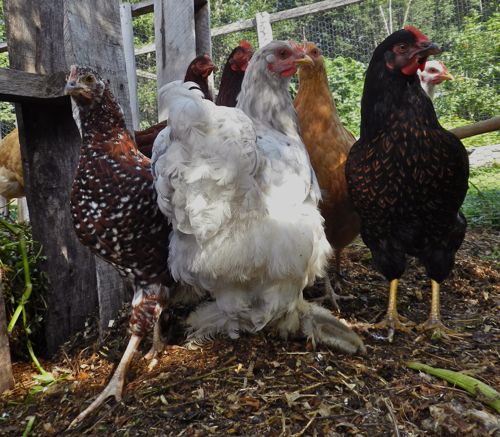
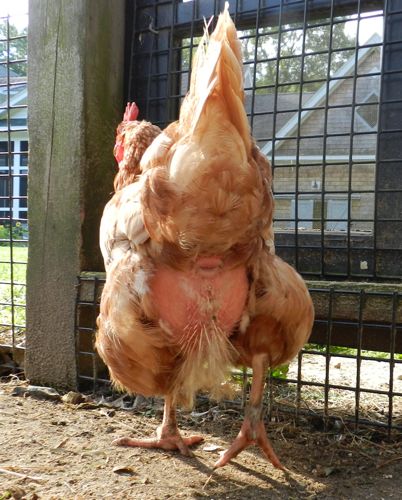
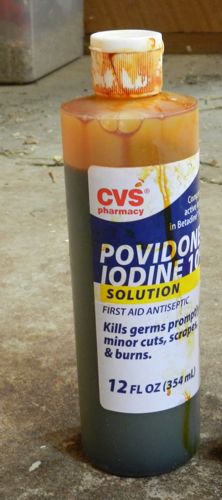
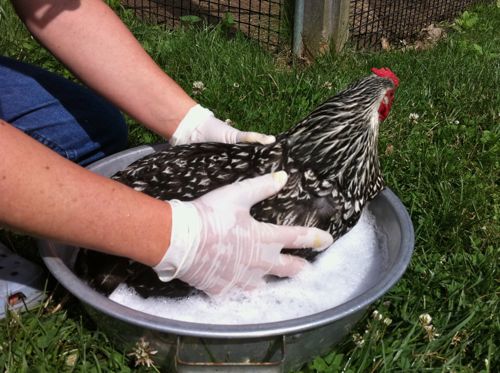
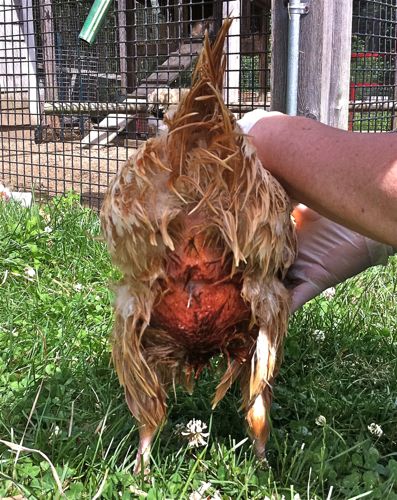
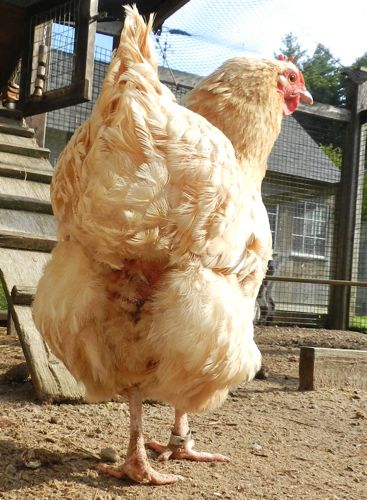
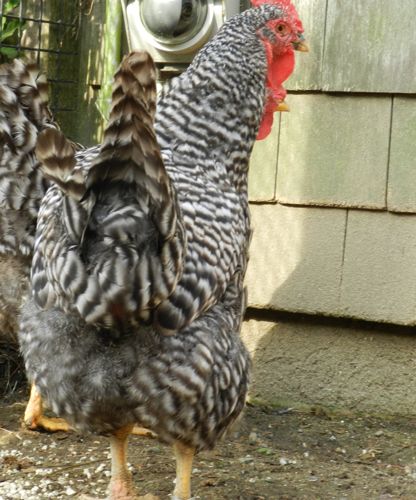

Wow, what a great chicken vet. you are. Their sorry little bottoms look wonderful two months later.
A very useful and informative blog, thanks! I am sure I will need to re-visit it again when one of my girls has need for an urgent visit to the beauty parlour! Does the iodine-type product cure vent gleet, then?
If you are interested, I wrote a piece last year on the trials of giving my Light Sussex, Araminta, a bath, hen-bathing being something I prefer to avoid!!
http://www.clickcluck.co.uk/in-the-hen-garden/the-bathing-belle/
PS Your hens are lovely and the before-and-after-photos made me smile!
I must say, Terry, it isn’t often that you get to read about a hen’s backside. Your site never ceases to amaze me! Checking out hencam is the first thing I do when I turn on my computer each morning. I don’t have chickens, but you make me wish I did!
I am on an odd career path, aren’t I? :)
Hi there… gonna try this as one of my leghorns has had this issue for months. Epsom salt via syringe didn’t do it nor does cider vinegar in the water all summer. Gotta go to the drug store…
Thanks!
C
Let me know if it works for her.
Hi!
After reading your post I have a question I’d like to ask. I have trouble handling my chickens without them getting really stressed, and I don’t like upsetting them. I know it is important to handle them regularly to monitor their health, but I find scooping one up into my arms sends the others running from me, and it seems to affect their confidence in me.
Do you have any advice about building up their trust and handling them more? Thank you! x
Have you watched my video on youtube?
http://www.youtube.com/user/thehencam#p/u/3/ZJdkmgiUqs8
Also, the majority of chickens don’t want to be held (there are exceptions like Coco and Agatha). For those, they should be used to you and see you as a good thing (i.e. a food dispenser.) Bring a stool into their run, get a hen and down with it on your lap. Hold wings gently but firmly so she can’t flap. When she relaxes, you relax. She’ll quickly learn that if she stays still on your lap that she won’t be restricted and she’ll calmly stay put.
Very informative! I have a hen who has been half naked for a year and I’ve been at a loss as to how to help her. I’ve tried different things but her feathers wouldn’t grow. So I’ve been giving her yogurt every day as soon as I saw feathers start growing on her wings and back. I am thrilled to say that her feathers are growing and her back is now covered. Unfortunately, her back end has stayed naked. Maybe this will help so I’m definitely going to try it. She doesn’t like being handled so it might be a little unsettling, but hopefully worth it.
There’s a lot of causes of feather loss. Usually bare backs are due to a rooster. Do you have one in the flock? She might be his favorite hen.
BTW, although yogurt is useful for supplying probiotics and calcium, I’ve read that it should not be an everyday food. A few days to a week of it as a treat is good, but too much calcium causes problems in the long run.
I have a rooster but this was more excessive than what he’s done to his girls. This extended around her torso too. It’s as if she molted last year and just couldn’t grow new feathers. Finally a few weeks ago I noticed the blue-ish shafts (She’s a Barred Rock). She seemed a little fatigued and since I’d read that growing feathers requires more protein, I thought some yogurt would help. Of course I could feed her chicken instead! LOL!! Good to know about the yogurt in excess. They all share one little container so I don’t think it’s a lot, but maybe so. Thanks:-)
I just had a really nasty situation with one of my hens getting an infestation of fly maggots on her bottom. My chickens have a super clean environment but here in Alabama it’s been very hot and humid and I think when she molted a few tail feathers an opportunity presented itself for infestation. My only clue was that she was acting lethargic one day so while observing her (she’s hard to catch) I noticed a patch of small fly maggots when she fluffed her feathers. Oh my goodness! I bathed her in warm epsom salt bath, thought I got rid of them, called the vet for a game plan then the next day when bathing I found a lot more that I didn’t see plus necrotic tissue. I freaked out, chicken looked like she was going into shock, called the vet, took her in (after hours) for euthanasia, chicken showed some spirit, vet and I thought she deserved a chance, cleaned out maggots with hydrogen peroxide, she got a shot for pain and infection, brought her home to stay in the house for a week of wound cleaning using Veterycin (expensive but works!) She’s back with the other girls and is happier than I’ve ever seen her. Sorry for such a long post but it was traumatic for the whole family. They had to assist in wound care.
I lost a hen to what is called “fly strike”. That’s really something that you were able to save your chicken. Go to to this post
to read what happened here, with not as good an outcome as you had. Rest assured that it can happen in a clean barn! Does your vet know about chickens or did he/she wing it? (pun sort of intended…)
Thanks Terry, that’s really helpful! I’ll try that technique and see how it goes!
Terry, I really appreciated that info from the 2008 post. I had such trouble with guilt when I discovered the maggots. We have a wonderful vet who is well rounded in animal care. He and his vet wife treat exotic animals too. He gave me a pep talk and helped my spirits as well as helping to save my chicken. I realize how lucky we were. I understand now that those things multiply so quickly.
Thanks Terry! Great tips…that I am sure I will use in the future.
that is some usfel info.it turns out that I will be getting my silkie today and I just need to know of do i introduce mt silkie to my other chickens?
Check my FAQs. I’ve got one about introducing new birds to an established flock.
Wow! Amazing results!
i got my silkies today and they are soo cute
here I am sitting at my desk, 8: 15 Monday morning and I am looking at chicken butts. And finding it fasinating. What does that saya bout me?? I have no idea. but you do find some of the most interesting things to share, Terry. That is for sure. Thanks for getting my week off to an interesting start!
Terry
How many times did you have to apply the Povidone iodine?
Just once for the messy bottoms! Amazing stuff.
terry,introduceing my silkies to my other chickens has been very hard i have them in diffrent pens so they could get used to each other and i let them out when i go to feed them but today my rooster was trying to attack them what should i do??
and my hen was trying to attack them
Give them more time. Have them live in a pen next to the flock so they can see each other through the fence. Are they all the same age? I hope you can integrate them but it might not be possible if the rooster doesn’t see them as pretty but as threats. Also I’d worry about putting silkies in with a large dominant roo. Use your best judgement! Good luck!
no they are not the same age so i will keep them in diffrent pens for a while thanks for the advice and i hope my roo will accept them
I just followed your directions with my Rhode Island Red who has had a bottom similar looking to Buffy’s. She was very sweet about getting the treatment, but I think the Providone was a little irritating? She is happily roosting for the evening now. I hope it works. Thanks for your blog!
Thank you for the info on vent gleet. I treated 4 hens last night. I have a new tydyed shirt:-). My older than dirt barred rock, No Neck, was going downhill fast. I dug a hole for her :-(. Today, she is getting her sea legs back and is starting to boss everyone around a lil. Still have the hole ready, but she looks a lot better! Thank you, Terry.
That’s great! (well, not about the shirt, but I warned you.) Even if No Neck passes, at least her last days will have been more comfortable.